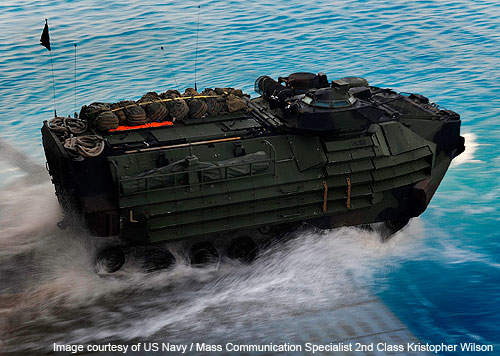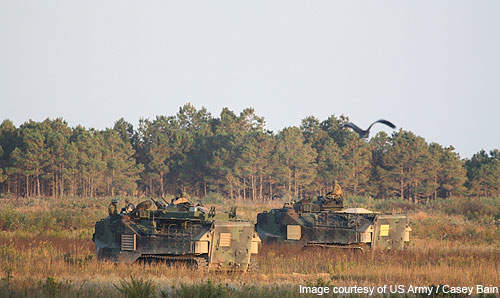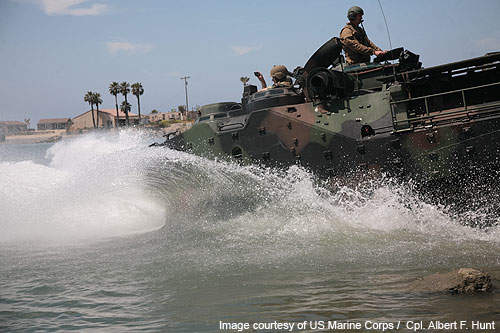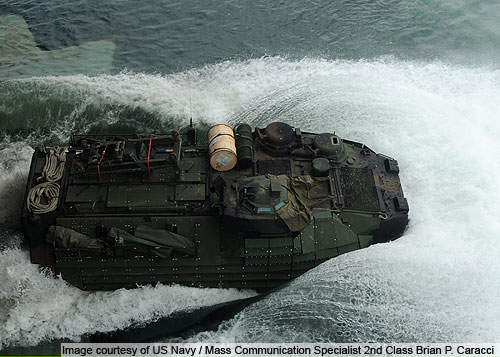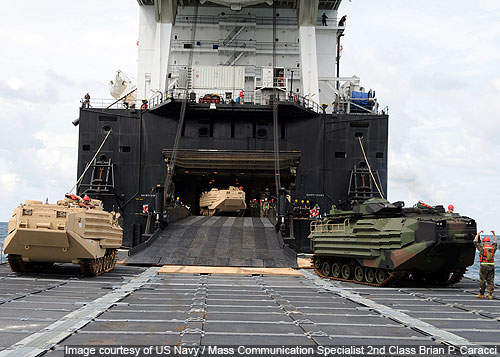The AAV7A1 family currently serves as amphibious troop transport vehicles for the United States Marine Corps (USMC). It is used to ground surface assault components and equipment of the landing forces in a single lift from assault ships during amphibious operations. It also supports mechanised operations ashore.
The AAV7A1 of the USMC are often referred to as Amtracks.
The vehicle designated Korea Amphibious Assault Vehicle (KAAV) KAAV7A1 is in service with the Republic of Korea Marine Corps. AAV7A1 was also exported to Argentina, Brazil, Cambodia, Italy, Taiwan, Spain, Thailand and Venezuela.
AAV7A1 assault amphibious vehicle development
The AAV7A1 first entered service as LVT-7 to replace the LVT-5 in 1972. The LVT-7 vehicle was converted into the improved AAV7A1 vehicle under the LVT-7 Service Life Extension Program completed between 1983 and 1986.
A new advanced engine, transmission and weapons system were added and overall maintainability of the vehicle was improved. The upgraded vehicles were originally called LVT-7A1, but renamed as AAV7A1 by the USMC in 1984.
The lethality, survivability and communications of the vehicle were improved under Product Improvement Programme (PIP) implemented during 1987-1999. The AAV7A1 Reliability, Availability and Maintainability / Rebuild to Standard (RAM/RS) Programme replaced the engine and suspension with M2 Bradley Fighting Vehicle (BFV) components modified for the AAV. The RAM/RS programme, commenced in 1999 was concluded in 2007.
AAV7A1 design and features
The AAV7A1 features a vessel-shaped hull. The headlight clusters are housed in a square recess. The improved versions are fitted with new instrument panel, a night vision device and a new ventilation system.
The hydraulically controlled bow plane provides stability when operating afloat. Extra protection is provided by the enhanced applique armor kits (EAAK).
Mission variants
AAV7A1 is available in three variants, namely the AAVC7A1 Command Vehicle, AAVP7A1 Personnel Vehicle and AAVR7A1 Recovery Vehicle.
The AAVC7A1 Command Vehicle lacks a turret. The communications equipment is accommodated in the cargo space of the vehicle. This version is equipped with modern communication systems, supporting arms and logistical support units.
The variant can carry three crew members, five radio operators, three staff members and two commanding officers. The vehicle has been upgraded to accommodate Harris Falcon II class radios.
The AAVP7A1 Personnel Vehicle features a turret fitted with a M2HB .50 calibre heavy machine gun and an Mk19 40mm automatic grenade launcher. It is equipped with four crew radios and an AN/VIC-2 intercom system. The variant can carry a driver, a crew chief / vehicle commander (gunner) and rear crewman, and 25 combat equipped Marines. The P7 can be modified to carry the Mk 154 Mine Clearance Line Charge kit.
The AAVR7A1 Recovery Vehicle is not equipped with a turret. The R7 features a crane, capacity recovery winch, cutting, welding and other portable maintenance equipment to provide support maintenance to vehicles in the field. It is used to recover similar or smaller size vehicles.
Armament
The new turret carries an MK19 40mm grenade launcher (K4) and a .50 machine gun (K6) in a coaxial mount.
The weapon station allows the gunner to engage targets within 1,500m range and to traverse a full 360° at a speed of 45° per second.
Self-protection
The all-welded aluminium hull safeguards the crew from small arms fire, shell splinters and flash bums. The enhanced applique armor (EAAK) fitted to the hull suppresses the residual penetration of shaped charge munitions.
The AAV7A1 is also installed with auto fire suppression and NBC protection system for enhanced survivability.
Engine
The AAV7A1 is powered by a 400hp turbocharged multi-fuel, liquid cooled V-8 diesel engine coupled to a HS-400-3A1 automatic transmission integrating shifting, steering and braking functions in one unit.
Mobility
The two 14,000gpm water jet pumps provide a cruising speed of 9.7km/h on the sea and the ability to negotiate 10ft plunging surfs flowing towards sea or shore.
The flat track torsion bar suspension system with heavy-duty shock absorbers provides excellent mobility over all terrains at a top speed of 72.4km/h.

